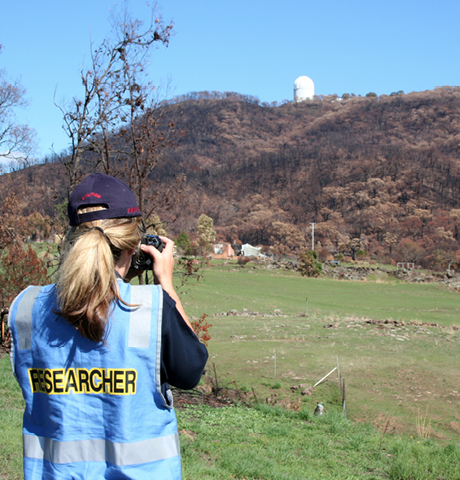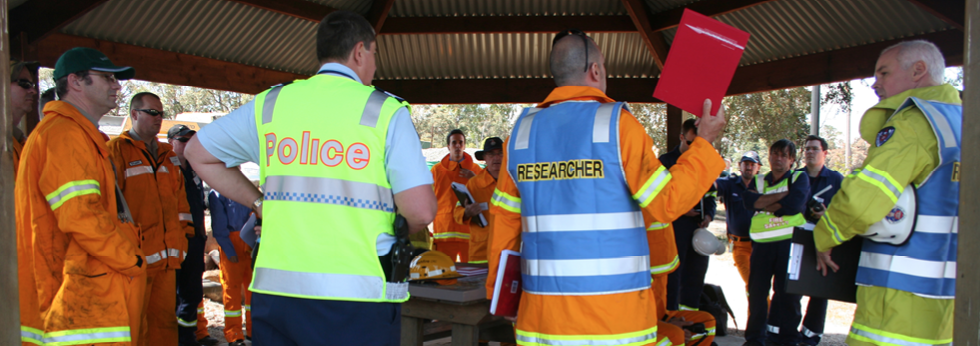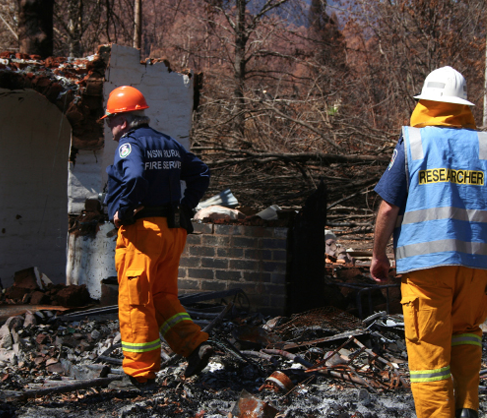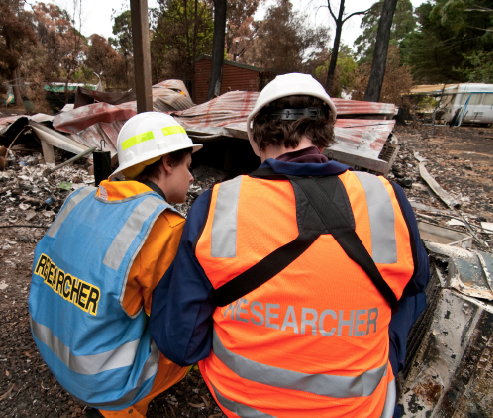
By David Bruce, Communications Manager, Bushfire and Natural Hazards Cooperative Research Centre
Research activities that follow major natural hazards are co-ordinated nationally by the Bushfire and Natural Hazards Cooperative Research Centre (BNHCRC) for emergency services organisations. This research has provided fundamental information for these organisations on what drives community behaviour during an emergency event, the policies that relate to the protection of lives and property, and the effectiveness of those policies.
Until now, bushfire has been the hazard in focus, but the scope is about to broaden to other natural hazards with a broader set of research possibilities.
In the aftermath of the 7 February 2009 Black Saturday fires in Victoria, the Bushfire Cooperative Research Centre assembled a large taskforce of researchers and fire and emergency services staff from across Australia and New Zealand. The taskforce gathered vital data from fire-affected areas related to fire behaviour, property loss, and community behaviour. This post-fire research provided information to the 2009 Victorian Bushfires Royal Commission. The Bushfire CRC used this research as a template for community surveying and research after major fire activity, and it now continues to be undertaken by the BNHCRC for emergency services organisations.
While traditionally the BNHCRC has facilitated post-event research activities following bushfires, these types of research activities are equally applicable to other natural hazards, including major storms, cyclones, floods and earthquakes. The same reasoning applies to the type of research undertaken. There has been a strong focus on community impact studies in the past, however there are a range of other areas where the CRC could provide research support following an event, including business impacts and effects on buildings and infrastructure.
Information collected in post-event studies such as those undertaken following Black Saturday and other significant fires, assists emergency services organisations to understand what drives community behaviour and the affects of certain policies and programs. This knowledge directly informs policies, programs and funding related to the protection of lives and property and enables these agencies to better monitor the effects of these policies.

Research teams at the Siding Spring Observatory in Coonabarabran, New South Wales after the summer fires of 2013.
The diversity of agencies and their needs for post-event research activities across all natural hazards has driven the CRC to develop a standardised approach to post-event research activities. A workshop in May 2015 with the Australasian Fire and Emergency Service Authorities Council Community Engagement Technical Group was a first key step to understanding client needs in this area.
High-level research themes identified at the May workshop include:
These research themes could be adapted for all natural hazards in all jurisdictions and cover a range of issues, including and beyond community impacts.
Every jurisdiction identified similar uses for the post-event research including:
The BNHCRC is now working on a range of suggestions that will streamline the post-incident research process and help agencies overcome challenges in study design and commissioning. These include:

Staff from across the emergency services sector move into the areas around Wandong hit by the Black Saturday fires in 2009.
This case study illustrates the broad value of post-event research, and how it can challenge assumptions about community hazards education, and point to possible policy changes.
The case study describes the work of the BNHCRC and the Bushfire CRC researchers interviewing communities affected by destructive bushfires in Victoria, Western Australia, Tasmania and New South Wales from 2009–2014. Research was conducted at the request of fire agencies in those states and their purpose was to inform agencies about how residents understood bushfire risk, planned and prepared for a possible bushfire, and responded to a serious bushfire event.
The New South Wales Rural Fire Service worked with both CRCs after major fires in 2013, which was one of the most challenging and dangerous years for bushfires in NSW in more than a decade.
Anthony Clark, Group Manager of Corporate Communications at the New South Wales Rural Fire Service said the studies contributed to the national research agenda.
‘These fires presented an opportunity to learn and refine our processes, particularly in relation to community preparedness and the delivery of information and warnings. The research has delivered benefits, influencing our approach to community engagement, as well as improving our understanding of how the public uses and responds to information and warnings, and the barriers that may prevent people responding,’ he said.
The main researcher in all these studies was Dr Jim McLennan, an adjunct professor in the School of Psychology and Public Health at La Trobe University.
High-level findings from all studies include:
Different motivations drove residents’ choices of household bushfire planning. Residents who planned to leave indicated this was because of the perceived danger that would be posed by a bushfire, especially if the household included vulnerable members such as the elderly, the disabled or young children.
Most residents who planned to stay and defend did so in order to protect their valued property—of either financial or emotional value, or a combination of both. Staying and defending was seldom understood by residents as a bushfire survival plan, rather it was understood by most to be asset-protection involving some level of acceptable risk.
Residents who intended to wait and see what developed before making a final decision typically did this because:
The findings suggest that fire agencies have been only moderately successful in raising overall levels of bushfire preparedness in at-risk communities. Impressions reported by interviewers suggest that more residents understand the inherent dangers posed by bushfires than was the case before Black Saturday in 2009. More residents view staying and defending as a course of action that involves a degree of risk and is not a choice to be made lightly. However, the findings from six post-Black Saturday interview studies suggest that overall levels of bushfire threat readiness among residents in at-risk communities remain lower than desired by fire and emergency services agencies.
Probably the most pressing need is for new approaches to increase the numbers of residents in at-risk communities who have planned and prepared appropriately to survive a future serious bushfire threat. Most agencies rely heavily on making detailed written information about bushfire safety available and exhorting householders to read this and act on it. Decades of research into health promotion and injury prevention demonstrate that education-based approaches alone result in limited improvements at best. Success stories such as lowering the road toll and reducing smoking rates involved costly mixes of innovative approaches to motivation and education, engineering solutions, legislation, sanctions, incentives and enforcement. There is no reason to believe that improving community bushfire safety will prove any easier. The BNHCRC research program is currently investigating new approaches to community warnings before, during and after hazard events.


Researchers inspect property damage at Marysville and Kinglake after the 2009 Black Saturday fires in Victoria.